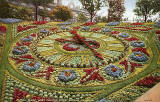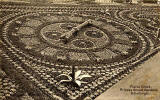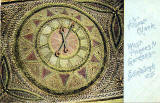|
Background Notes on Edinburgh Floral Clock |
|
West Princes Street Gardens Edinburgh's floral clock can be found in the NE corner of West Princes Street Gardens, beside the steps leading into the gardens from the foot of the Mound, and beneath the statue of Allan Ramsay. It is believed to be the oldest floral clock in the world. Each Spring, the clock is replanted to a different design. Since 1946, the floral clock has celebrated a different event or anniversary each year. |
|
The 1903 Clock Edinburgh's first floral clock was created on this site in 1903. It was the brainchild of the Edinburgh Parks Superintendent, John McHattie. He had been inspired by a carpet bedding display in Princes Street Gardens created the previous year to commemorate the Coronation of King Edward VII on August 9, 1902. The Edinburgh firm, Ritchie & Son, clock manufacturers and repairers since 1809, installed the mechanism for Edinburgh's first floral clock, and is still responsible for maintaining the clock and many other public clocks in Edinburgh. The jeweller Mr Mossman, who had a shop at the East End of Princes Street, assisted John McHattie in designing the 1903 clock. Mr Mossman was a direct descendant of James Mossman, a court jeweller to Mary Queen of Scots. The 1903 clock had only an hour hand. Its length was 4ft 2 ins. The clock began to operate on June 10, 1903. |
|
The 1904 Clock From 1904 onwards, the clock had both an hour hand and a minute hand. The lengths of the hands of the 1903 clock were 5ft 2ins and 8ft 5ins. |
|
1905 Onwards From 1905 onwards, a mechanism was added to reproduce the sound of a cuckoo, every fifteen minutes. The sound was produced by two organ bellows and organ pipes, but there was no model cuckoo to be seen. By 1950, the sound of the cuckoo had become almost drowned by the noise of nearby traffic, so a new cuckoo sound system, including loudspeaker, was installed. A model cuckoo was also added, appearing out of its housing every fifteen minutes. Until 1972, Edinburgh's floral clock operated mechanically. It needed to be wound daily. In 1973 it was converted, by Ritchie, to become electrically driven. |
|
Clock Designs The face of Edinburgh's floral clock is 11ft 10ins diameter. - In the 1930s, about 13,000 plants were used to create the clock. - By the 1950s-60s, the number had increased to 25,000. - By the 1980s, the number had increased to around 35,000. It took 3 gardeners about 3 weeks to plant the flowers each year (or it did in 1998!) Until 1993, the plants were taken to Princes Street Gardens and planted individually in the clock. Now, sixteen stainless steel containers, already planted, are brought to the gardens from the nurseries at the Inch. There is one container for each of the clock's numbers and four for the centre of the clock. Edinburgh's early floral clocks had clock faces planted with numbers for the hours. The faces were planted in various geometric shapes, but no words were included in the designs until around 1927. The first words to appear on the clock were "TEMPUS FUGIT" (Latin for 'Time Flies'). |
|
Copies around the World Early copies of the floral clock were created in Edinburgh for display in: - New Zealand - Australia - India - South America - Canada Ritchie & Sons Ltd, between 1919 and 1939 went on to install floral clock mechanisms in several English seaside resorts: - Blackpool - Bridlington - Brighton & Hove - Southend-on-Sea - Southport - Weymouth as well as mechanisms for two floral clocks in Liverpool The Southend-on-Sea clock is the largest in Britain, with a face 20ft in diameter. |
|
100 yrs on ... A full-size replica of Edinburgh's floral clock was created and displayed at the Chelsea Flower Show in London in 2003, to commemorate the centenary of the Edinburgh clock. This replica was awarded a Gold Medal at the flower show. Since 2003, there have been two clocks planted each year, both on the same site at the NE corner of West Princes Street Gardens - a Summer Clock then a Winter Clock. |
|
James Ritchie The floral clock is still (in 2006) maintained by the same firm as helped to create the original Edinburgh floral clock, James Ritchie & Sons Ltd, clock and watchmakers. The works for the clock are installed in the base of the Alan Ramsay statue beside the clock - not underground! In the early years the clock works installed by Ritchie & Son came from a clock the company were dismantling at Elie Parish Church in Fife. These works lasted until 1936, when they were replaced. Ritchie started their business in Leith Street in 1808 and are now based only a few hundred yards away in Broughton Street. Ritchie are also responsible for winding and maintaining public clocks in Edinburgh. |
|
The notes above are based on articles in: - Edinburgh Evening News June 10, 1998 and June 10, 2003 - The Scots Magazine: April 1954, pp.74-75 (details concerning Ritchie & Sons Ltd) and an article by Malcolm Fife c.1994 based mainly on an Edinburgh District Council Leaflet about the clock dated c1960s-70s. |
|
Floral Clock |
Floral Clock |
Floral Clock |
Floral Clock |


